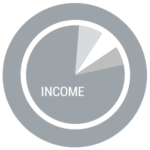Once we have an idea of what pollution sources are most significant, our decision-making process needs to include an analysis of which solution we should implement to address the identified problem.
By using a Sustainable Return on Investment (SROI) approach to capture the “triple bottom line” of each possible solution, we are able to monetize not only the environmental, but also the economic and social benefits of each possible solution. Our goal is to build a methodology so we can then make an apples-to-apples comparison between solutions.
SROI Venn Diagram

As a pilot, we conducted an SROI analysis on nine total alternatives among four types of projects:
- Stormwater Detention Basin Retrofits
- Enhanced Nutrient Removal at the Wastewater Treatment Plant
- Coal Tar-Based Sealant Reductions
- Sanitary Sewer Overflow Controls
Looking at these alternatives, we begin to realize that if our goal is the quality of the water in the stream, our decision-making needs to consider the solution on which we should we spend our first dollar.
Regulations will lead us to one answer. Integrated Planning may lead us somewhere else.
Takeaways:
- The best value options include stormwater detention basin retrofits for water quality improvements and policies to reduce polycyclic aromatic hydrocarbon use.
- Higher levels of sanitary sewer overflow control do not appear to pay for themselves.
Learn more about SROI (Sustainable Return on Investment):
- Final SROI pilot report (pdf, 2017)
- SROI at a Glance (pdf, 2017)
- Alternative Livestock Watering Opportunity – DRAFT (pdf, 2019)
- Detention Basin Retrofits (pdf, 2019)
- Enhanced Nutrient Removal at the Southwest Wastewater Treatment Plant (pdf, 2019)
- Floatable Controls (pdf, 2020)
- Polycyclic Aromatic Hydrocarbon Reduction (pdf, 2019)
- Public Education & Outreach (pdf, 2020)
- Riparian Restoration (pdf, 2020)
- Sanitary Sewer Overflow Reduction (pdf, 2019)
- Septic System Elimination – DRAFT (pdf, 2019)
- Street Sweeping (pdf, 2019)




